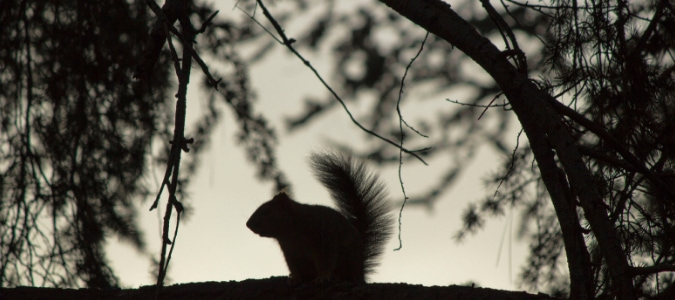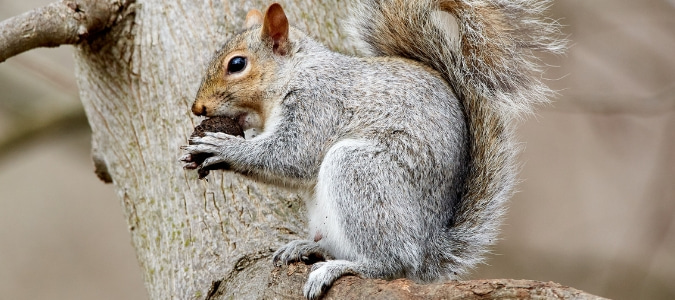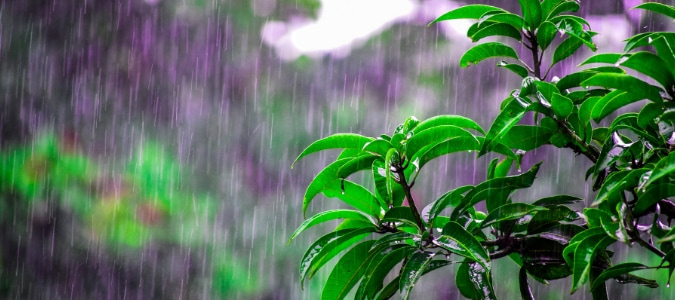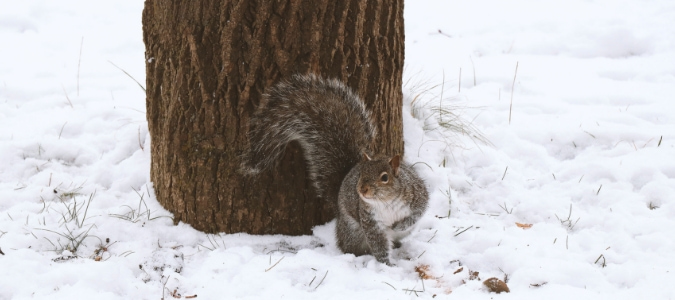Where Do Squirrels Sleep?
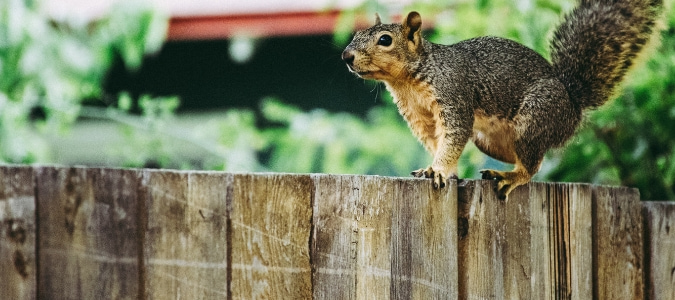
Until that one fateful night when you heard scritch-scratching in your walls. When you investigated, you almost got an eye full of acorns.
Squirrels moved in.
How did this happen? More importantly, what are you supposed to do about it?
You didn’t want to kill these creatures, but sharing your home with squirrels doesn’t seem like a good idea, either.
While squirrels may seem cute and cuddly, having them inside your home is an entirely different matter. When a squirrel nests in a house, these critters may damage the property, lower its value, eat and destroy food and even spread diseases. No one here in Central Texas wants that.
Most people think it’s just a matter of getting the squirrels back into their tree, but that’s not always the case. In fact, some types of squirrels don’t live in trees at all, and others seek out warmer places when the weather gets cold.
Because of these facts, we’re going to lay out the various sleeping and living habits of squirrels in this post so that you get a better sense of why they might move into your home and what to do about it if you are the unfortunate host to a squirrel visitor.
Where Do Squirrels Live At Night?
Despite their energetic, playful-seeming behavior, most squirrels’ time is actually spent sleeping. A squirrel spends up to 60% of its day asleep, which means that an average squirrel sleeps for almost 15 hours each day.
Nice if you can get it, right?
Obviously, this differs depending on the type of squirrel, though, so it’s worth taking a moment to break down the various squirrel species that you might run across in your yard or hiding out in your home.
Squirrels are found in every continent on Earth, apart from Antarctica and Australia, and there are over 200 species. However, all of them can be categorized into three primary types of squirrels:
- Flying squirrels
- Ground squirrels
- Tree squirrels
Flying Squirrels
Despite their name, flying squirrels do not actually fly. Not exactly.
But it can sometimes seem like it due to the web-like skin flaps on their sides. These flaps let these animals glide from one tree to the next, giving the appearance of flight.
Flying squirrels live in tree dens. They build these homes in summer using bark, grass, leaves, small twigs and moss. Sometimes, you may run across dens in treehouses or home attics, and it’s not uncommon to see a flying squirrel sleeping on a tree branch or a hollowed-out hole in a tree.
Tree Squirrels
Gray, Red and Fox squirrels are the most common types of tree squirrels. Red squirrels are predominantly found in Europe, while Gray and Fox squirrels are found here in America.
Gray squirrels have big eyes. Red squirrels have a coat made up of reddish-brown fur. Nevertheless, squirrels may change their color when they shed this coat during the summer. Therefore, a gray squirrel may have coats that appear gray, white, black or brown.
Tree squirrels sleep in dreys. A drey is made using twigs, branches, leaves and mosses. The squirrels strategically position the drey between tree branch forks. Dreys are sometimes found in attics or along the wall of a house.
Ground Squirrels
Most of a ground squirrel’s time is spent—you guessed it—on the ground. These creatures sleep in ground-level burrows. In the northern states, where winters are frigid, ground squirrels hibernate throughout the winter. On the other end of the spectrum, ground squirrels that live in deserts and other extremely hot climates estivate (essentially hot-weather hibernating) during summer when the temperatures are hottest.
During estivation, a squirrel spends most of its time sleeping in an underground burrow that shields it from the hot sun above ground. Squirrels may estivate for up to seven months.
What Time Do Squirrels Go To Sleep?
So, how are squirrels getting that amazing-sounding almost 15 hours of sleep each day?
They’re crepuscular, which means they’re only active at dusk and dawn. At least, that’s true for most of these animals. Some species, especially tree squirrels, love the sun and may remain out of their nests all day long during the summer.
When they’re not running around looking for and hoarding food—or mating—squirrels will be in their nests resting or sleeping. Since most of the animals that prey on squirrels here in the greater Austin area are nocturnal, you can bet that they try to avoid predators by staying in their nests at night.
Where Do Squirrels Sleep When It Rains?
Squirrels are small animals. They have a small body to surface area ratio, which makes them lose their body heat more rapidly than large animals. Therefore, it’s vital that their bodies don’t get soaked by rain, because when they do, the water makes it even harder for the little mammals to control their core body temperature.
How do squirrels keep from getting soaked from our infrequent, but often heavy, rainstorms here in Austin?
They’ve got a couple of tricks. First, they use their bushy tails to shield themselves from the rain. They flip the tail over their body, using it as an umbrella of sorts. Though the tail may get soaked, the rest of the body remains relatively dry. Nevertheless, this works best as protection against light rain.
Squirrels escape heavy downpours by hiding in their nests. The nests are usually built and strategically positioned in such a way that they offer maximum protection against rain and cold. In this way, a squirrel can survive heavy downpours and thunderstorms.
Where Do Squirrels Sleep In Winter?
While most homeowners want a straightforward answer to this question, the truth is that it depends on the squirrel. An accurate response becomes even more complicated when we consider that we so rarely get cold weather here in Central Texas, so squirrels often have similar sleeping habits all year long.
Ground squirrels hibernate during winter. Flying and tree squirrels, on the other hand, do not hibernate. Squirrels that do not hibernate usually fortify their nests, thereby providing better insulation and protection against the cold winter weather. Flying squirrels also believe in safety in numbers and may live together in groups of 10 or more during colder months.
When ground squirrels hibernate, they go into their burrows and sleep. They conserve energy by drastically lowering their body’s metabolic processes and going into a state of prolonged sleep. Ground squirrels that are in hibernation may sleep for as long as five months. The sleep is not complete, though. During each week of hibernation, they might actually be awake for between 12 and 20 hours.
When Do Squirrels Move Into Your Home?
Like most wild animals, squirrels may be attracted to your home due to the fact that it is safe from harsh outdoor conditions like extreme temperatures, predators and unfavorable weather.
So, there’s the first part of your answer. They move in when the conditions inside seem better than they do outside. What does that mean? Squirrels may be attracted to your home under a few conditions.
Hot Weather
If your choices involved temperatures of over 100 degrees or comfortable air conditioning, what would you choose? Probably the same option as a squirrel.
Cold Weather
Even though we don’t suffer the extreme cold of many northern states, Austin can still get pretty chilly outside, and we get frosts—and even snow—every once in a while. When this happens, your house probably seems pretty appealing.
Storms
Why risk getting blown out of your tree or flooded when you can simply set up shop inside the nice, cozy house with plenty of nooks and crannies.
When Predators Are Nearby
Hawks. Owls. Weasels. Foxes. If your family was on the run from any of these vicious creatures, you’d want safety and security, too. That’s what your house represents.
How do squirrels get into your house, then?
These rodents squeeze their way in through small holes and gaps on the walls, doors, windows, floors or roof. Some of the more aggressive squirrels may even chew their way in. Once inside the house, the rodent sets up nests in hidden places such as the attic, ceiling, chimney and within the walls.
Dangers Of Having Squirrels In Your Home
We briefly touched on this above, but squirrels that get into a home are a menace not just to the home itself, but also to those living in that home. Squirrels can damage your property, spread disease and put your family at risk.
Increased Risk Of Fires And Electrocution
There have been numerous reports of squirrels gnawing at power cables. Once they chew through a live electricity cable, they may get electrocuted. During the electrocution, the rodent may catch fire and, in the process, set your home ablaze.
Besides causing a house fire, they may also cause power outages in your home. The squirrel’s gnawing may also leave electricity wires exposed, which predisposes the home—and you—to the risk of accidental electrocution.
Bites, Scratches Or Other Injuries
Naturally, squirrels are shy critters that wouldn’t normally attack humans physically. However, there have been cases where large squirrels attack small children. Some of these attacks might be so vicious that they cause serious injury to a child. Squirrels can also bite or scratch a beloved family pet.
Property Damage
The front teeth of squirrels are so strong that the rodent can easily chew through the fascia and siding of a house. These pests can also gnaw through the roof shingles, damage the HVAC system, block vents, and gutters and even eat away parts of door frames and window sills.
This damage can bring down your home value, and making repairs is neither easy nor cheap.
Just as frustrating, squirrels often die in hard to reach areas. With time, dead squirrels begin to decay, which is not only unsanitary but also creates an offensive odor that permeates into your house.
Vehicle Damage
It’s not just your house and loved ones in dangers. Squirrels have been known to get into vehicle engines.
These creatures tend to hide away in cars that aren’t used frequently. Once inside, they may build a nest in the engine. It’s also in a squirrel’s nature to gnaw away at wires and various other vehicle components, and the resulting damage is often costly to fix.
Other Health Risks
Squirrels and their feces carry disease-causing elements such as salmonella and leptospirosis-causing bacteria. Additionally, squirrel-borne disease pathogens may cause such ailments as fever, headaches, abdominal pains, vomiting, enteric fever, gastroenteritis, food poisoning and more.
Signs That Your Home Has Squirrels
Squirrels are fairly large rodents. Therefore, it’s usually easy to tell when you have an uninvited guest in the form of a squirrel in your home. Experts recommend that you watch out for the following signs of squirrels in your home:
- Scampering, scratching or jumping noises in the attic, chimney or walls
- Damaged entry points like fascia boards, panels along the roof line and/or shingle damage
- Interior damage, which may include chewing on furniture, shredded ductwork, foul smells in the attic and chewing on electric wires.
- Visual identification of squirrels seen coming in or out of your house
Many people underestimate the destructive capabilities of the squirrel. All it takes is a slight gnaw and a little nibble from a bunch of persistent squirrels to cause some significant headaches in your home.
Prevent Wildlife From Moving In
Squirrels can be quite persistent if they decide to take up residence in yours. That’s why many Austin homeowners call in Chem-free to humanely handle these uninvited guests. Our experts apply their knowledge of animal behavior to identify how a rodent or another kind of animal is finding its way inside and help you take preventative measures to keep them from returning. With Chem-free’s help, you won’t have to worry about where rodents are sleeping and you’ll rest assured knowing it’s in a more natural habitat. Contact us today for an estimate!
Need Help Managing Pests?
Chem-Free offers both effective, low-impact pest control options and preventative measures to help avoid future infestations. Contact us today for a free estimate!


